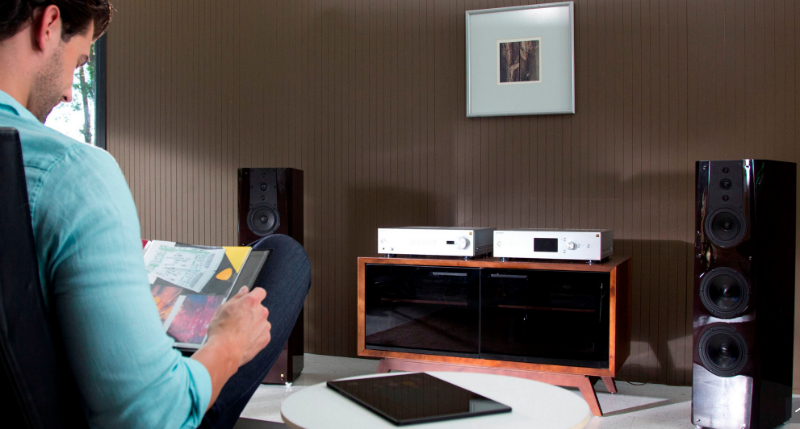How Sony makes high definition sound mainstream

The audio enthusiasts of the world of audio have almost disappeared from large international electronics exhibitions - more and more large and expensive TV screens, small wireless headphones and various “pieces from the future” that are hopelessly obsolete in a couple of years and no one will remember them are more often discussed at these events. .
However, recently, there have been signs that the situation is changing - perhaps we have just reached the moment when the way we listen and hear in the future will change forever. Or, at least, when those of us who are sure that the future for high-quality audio — that is, uncompressed and compressed — can become happier.
')
Sony and the high-definition sound market
In the reports made by Sony at the same time during the annual IFA exhibition in Berlin and at the event at the Lincoln Center in New York, the company declared its commitment to high definition sound - it sees the future of recorded music as such. That is why Sony will support the development of hi-res audio format. In addition, the theme of high-definition sound has become one of the central ones at CES 2014.
Pono music
In addition, musician Neil Young announced the launch in 2014 in partnership with Meridian Audio of the PONO music system , with which a wide audience can get the sound of a “studio” quality. The project campaign on Kickstarter was extremely successful.
True, this project has its critics - the Gizmodo publication published a scathing material called “Why there is no point in the Pono music player”.
Nevertheless, a surge of interest in "audiophilia" and sound quality is obvious.
What's happening
Many may ask this question or, moreover, ask, why is this important at all? After all, many manufacturers of equipment for audiophiles nevertheless support digital formats hated by lovers of pure sound like mp3.
But when Sony Electronics President Phil Molyneux comes on the scene in front of a lot of people and says that “it’s time to offer high-definition audio products that allow a pure sound enthusiast to listen to your favorite music in your desired quality” it becomes obvious that everything is serious.
This means not just the release of various music playback systems with built-in disk storage and other similar things, but also support for global labels, like Sony Music (naturally), Universal Music Group and Warner Music Group.
Indeed, hi-res music by artists working with the labels listed will be uploaded to some new Sony products. As Matt Signore of Warner said:
Sony's preloaded music initiative will be able to show a large number of people the benefits of high definition sound - given the scale of the organization and its experience in marketing, there is no doubt about that.
In addition to creating products that make it easy to download, store and play MP3 music, the company is finally moving to support high-definition formats.
Further effort
There are also special vendor sites dedicated to high-definition audio products and this phenomenon itself. Here, for example, is the Sony website for UK users, and here is a resource for an audience from the USA. The task of these projects is to promote high-quality sound, as well as promoting relevant products and resources where you can find music in the right formats.
At CES 2014, much attention was paid to new Sony products for lovers of high-quality sound ( general audio results of the exhibition can be found in our topics - one , two ). In particular - the player HAP-Z1ES . The principle of operation of the device is not much different from the iPod (although it is much larger in size), but in terms of sound quality, the Sony product wins the Apple device in all respects. It can play - and “improve on the go” - sound of almost any format: DSD (DSF, DSDIFF with a frequency of 2.8 or 5.6 MHz), PCM (16, 24, or 32-bit with a frequency of 44.1, 48, 88.2, 96 , 176.4, or 192kHz), WAV, AIFF, FLAC, ALAC, ATRAC, ATRAC, MP3, AAC, or WMA.

In addition, the device has a disk of 1 terabyte for storing files. Plus, external drives can be connected to it. Another convenient feature is the ability to connect to the network, which allows you to listen to Internet radio.
Thanks to DSD Remastering Engine technology, Sony’s ineners have been able to give their product the ability to “restore” sound quality even for compressed digital file formats.
Yes, Sony could be more agile in promoting hi-end sound, because many people around the world already want to listen to music in high quality and spend a lot of money on the corresponding devices.
However, it is better late than never, and if Sony and other manufacturers manage to reduce the cost of access (with an acceptable level of quality) to hi-end music and popularize it, then among the broad masses of users can finally be born a request for high-quality sound. And this, in turn, will lead to increased competition and a further fall in prices and greater availability of high-quality sound.
Fans of high-quality music have been treading on the threshold for too long, not daring to enter the world of the mass market of the audio industry. It's time to finally take a step to the next level.
Posts and related links:
Source: https://habr.com/ru/post/230163/
All Articles